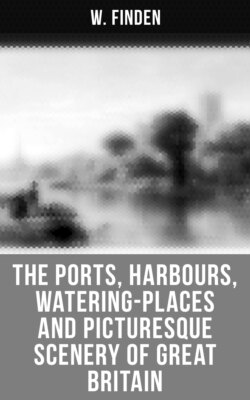Читать книгу The Ports, Harbours, Watering-places and Picturesque Scenery of Great Britain - W. Finden - Страница 11
На сайте Литреса книга снята с продажи.
CROMER.
ОглавлениеTable of Contents
Cromer is a fishing village, situated near the north-eastern extremity of the county of Norfolk. It lies about 129 miles north-north-east of London, and about 22 miles nearly due north of Norwich. The view in the engraving is taken from the sands, looking to the westward. Some years ago, part of the cliff, with two or three houses beyond those which are now seen standing on its extremity, fell down in consequence of the encroachments of the sea. At that time a subscription was entered into by the inhabitants of the place, and by several of the neighbouring gentry, for the purpose of forming a breakwater; for without some such protection it was apprehended that at no very distant period many more houses, with the fine old church, would fall a prey to the violence of the sea.
It is supposed that Cromer was formerly a place of much greater importance than it is at present; and that at the time of the Domesday survey it was included in the town of Shipden, which, with its church, is supposed to have been destroyed by the sea in the reign of Henry IV. At low water many large portions of wall are to be seen, which have evidently formed part of the houses of the old town of Shipden. "The set of the great tidal current of the German Ocean," says Mr. R. C. Taylor, in his Geology of East Norfolk, "is from the north-west, along the eastern shores of this island. In their progress southward, the tides meet with an extensive obstruction in the projecting county of Norfolk. About twenty miles of its coast has been subjected, from time immemorial, to the abrasive action of ocean currents. The ancient villages of Shipden, Wimpwell, and Eccles, have disappeared; several manors, and large portions of neighbouring parishes, have, piece after piece, been swallowed up by the encroaching waves; and their site, some fathoms deep, now forms a part of the bed of the German Ocean."
The sea in this neighbourhood, and on the whole of the Norfolk coast, is particularly dangerous. Between Flamborough and Spurn Heads, and Winterton Ness, the most easterly points of land on this side of the island (excepting the North Foreland), the land retreats inward, forming a large bay. If vessels leaving Flamborough Head proceed southward and meet with a hard gale from any point between north-east and south-east, or of leaving Yarmouth Roads, proceeding northwards, they are retarded by the wind blowing hard from the north-east; so that as they cannot weather Winterton Ness, they become embayed, and the only chance of safety is to run for Lynn Deeps, in attempting which they are in danger of foundering on the rocks near this town or stranding upon the flat shores between Cromer and Wells.
Cromer is much frequented in summer by visitors for the sake of sea-bathing, for which the fine sandy beach to the eastward affords great convenience. It is a place of very little trade, and is chiefly dependent on the fishery. Cromer light-house stands on an eminence, about three-quarters of a mile to the eastward of the village. It is a revolving light, and is visible, in clear weather, at a distance of five or six leagues. It appears in its brightest state once in every minute, and then gradually becomes eclipsed.
HULL.
